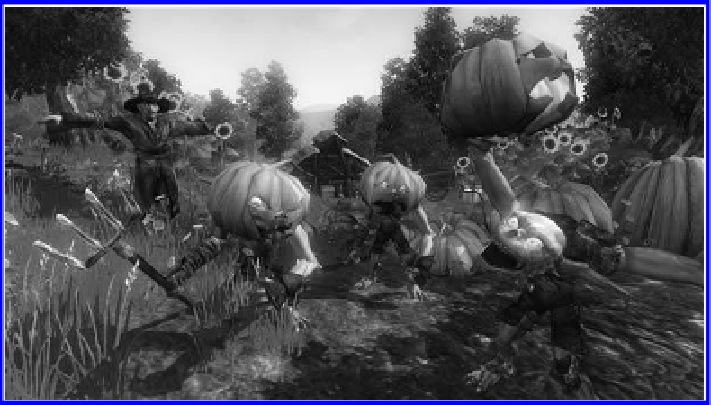Game Development Reference
In-Depth Information
Figure 14.3.
Overlord
allowed Minions to wear all sorts of items, like these natty pumpkin
hats.
player will hear ambient narrative. For this very reason, it's often where dialog and
story nuances have the most impact. So do not neglect your ambient dialogue—it
can really be an interactive writer's best friend.
As mentioned earlier, we cast our NPCs very specifically for our different do-
mains to help create this world idea and also to create a feel for the races within it. So
now an
Overlord
player would go into a future
Overlord
game expecting the peasants
to be affable but rather foolish, the elves to be sulky and deliberately overwrought,
and the dwarves to be little more than angry beards on legs who'll do anything for a
pint of beer and a pocket full of gold.
Expanding the World—
Overlord: Raising Hell
When we came to creating the expansion content,
Overlord: Raising Hell
,wespun
out the story by introducing a hell-themed sub-domain where the previously defeated
heroes and their cronies were going through perpetual punishments. The elves were
being forced to watch a play about their downfall, the halfling hero was forced to eat
and eat until he exploded, and the gold-obsessed dwarf king had been encased inside
a golden statue. Both the narrative themes and gameplay were created with the desire
to kick up the dark humor and evilness a few notches. This was in part a reaction to
some player feedback on the main game, namely that they didn't think you could be
quite wicked enough.
The solid base we'd established in the first game made it much easier to spin off
new mini-stories that felt coherent and linked to the original game, rather than just
being tacked on. Gnarl, the Minion Master character in the game and the player's
always on-hand guide, had proved very popular with players (thanks to the vocal
talents of Marc Silk), so we decided to make him play a central narrative role in the

















Search WWH ::

Custom Search